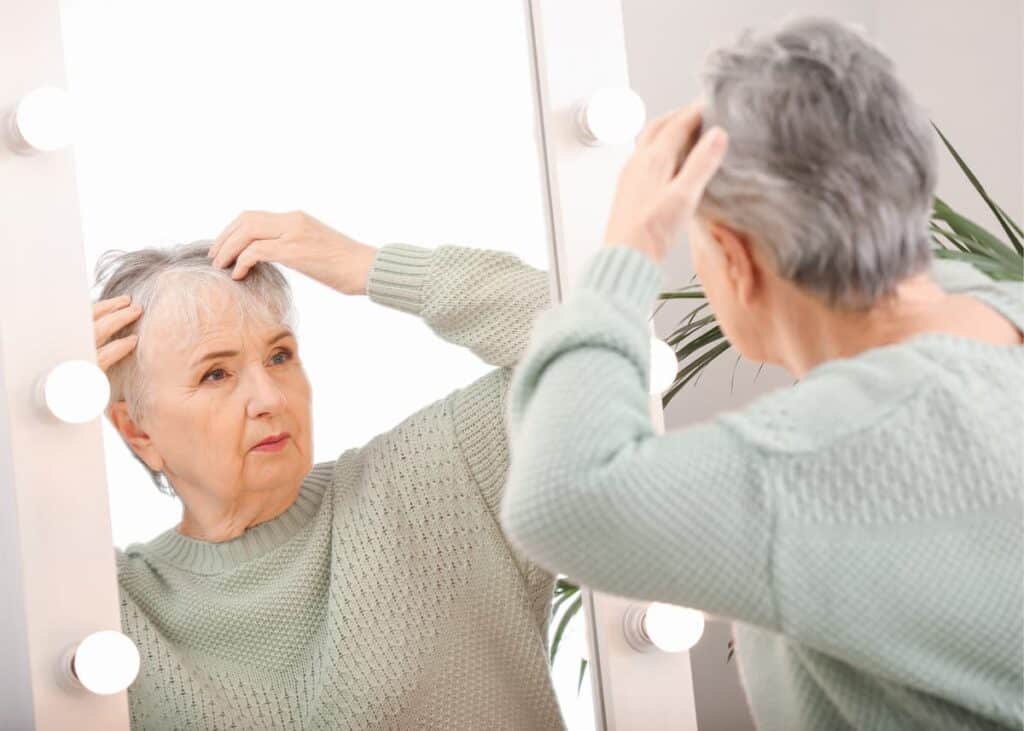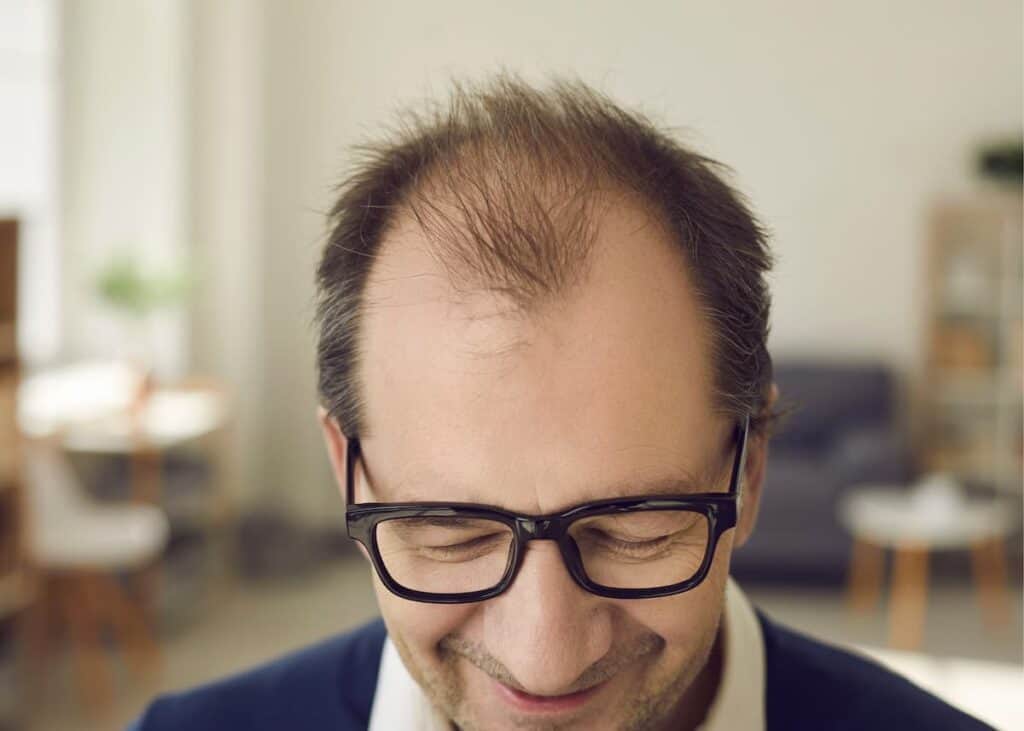Hair loss and hair thinning may not have any effect on your physical health, but it can have a very significant emotional toll. It commonly affects men over 50 and women who have already experienced menopause. The causes of hair loss vary wildly, for some, it’s simply a question of genetics, but there is also a myriad of things outside genetics that can cause pattern baldness, including post-pregnancy factors. It can be frustrating and even embarrassing, and ultimately, severely affect your self-confidence, luckily there are some things you can try to stimulate hair growth.

Causes of Bald Spots
We typically lose between fifty to a hundred hairs a day, but, as new hair is also constantly growing, we don’t notice it. The problem is when new hair stops replacing excessive hair loss.
Many things can cause thinning hair and hair loss. A lot of the time, it’s simply a product of time, aging, and genetics. It can happen to anyone, but it’s most common in men. This is called androgenetic alopecia, and it has a predictable pattern. For men this means a receding hairline and bald spots, for women, it means thinning of the hair in the crown of the scalp. These are commonly referred to as male pattern baldness and female pattern baldness respectively.
It can also be a side effect of certain drugs or medications. For example, those meant to treat cancer, arthritis, depression, heart problems, gout, and high blood pressure.
Many people experience hair loss after a traumatic event, or an emotional or physical shock, as it causes severe stress. This, however, is temporary.
Several medical conditions also cause or can cause hair loss. Alopecia areata, for example, is related to the immune system and causes hair loss. There is also patchy alopecia areata, which causes patchy hair loss. Ringworm or other skin infections affecting the scalp, and trichotillomania, a disorder that causes excessive hair pulling, and, ultimately, hair loss.
Hormonal changes can also cause either temporary or permanent hair loss, these can happen due to thyroid problems, pregnancy, childbirth, and menopause. Many women experience a temporary condition, something dermatologists call “excessive hair shedding” post-pregnancy, due to estrogen levels falling.
Lastly hot oil treatments and permanents can cause hair damage and hair loss, which, if there’s scarring, can be permanent. And frequently wearing hairstyles that pull on the hair, like pigtails, can cause traction alopecia, another type of hair loss.

Natural treatments for a bald spot
The simplest way to stimulate blood circulation in the scalp is to promote thicker hair growth. It improves scalp health, plus it can relieve tension and stress. Move your fingertips across your scalp in small circles while applying light or medium pressure for about five minutes every day. You can do it using oils, masks, or nothing at all.
Several different oils can help. Coconut oil or olive oil can be massaged into your scalp before or after washing your hair, depending on your hair type. Or mix a few drops of rosemary oil or geranium oil into a carrier oil, like argan or jojoba, and massage into your scalp before rinsing a couple of times a week, or mix a few drops into your shampoo or conditioner or conditioner daily. Both rosemary and geranium are an essential oil, and should always be mixed into a carrier before applying to the skin. A healthy scalp can mean healthy hair growth.
It’s also recommended that you eat a healthy diet rich in protein, vitamins, omega-3 fatty acids, iron, probiotics, and biotin to improve hair density. Some of the foods you may want to consider are salmon, walnuts, eggs, yogurt, spinach, and meat just to name a few.
If you can stand the smell, you could also try onion juice. It’s thought to improve hair circulation, promote hair growth, and has been shown to successfully treat patchy bald spots. Just blend a few onions and squeeze out the juice, apply it to your hair and scalp and leave it on for fifteen minutes before washing your hair.

Over-the-counter treatments for bald spots
If there’s an underlying disease causing your hair growth, it’s necessary to treat that condition. However, if that’s not the case, there are several over-the-counter treatment options for pattern baldness. The most common treatments are:
- Minoxidil, this is an effective topical treatment, it’s available in a liquid foam or as shampoo. Women should apply it once a day and men twice a day. Minoxidil has been found to help people regrow their hair (or slow the rate of hair loss) and/or help prevent new bald spots from forming. It will take at least six months of treatment for it to prevent additional hair loss and begin hair regeneration. To start seeing whether the treatment is working, may take a few extra months.
- Finasteride is a prescription drug for men, as a pill to be taken daily. It might take a few months to know whether it’s working for you, some men taking finasteride report reduced hair loss, and a few even see new hair growth.
- You could also try taking some supplements, vitamins a, b, c, d, e, iron, and zinc are all associated with hair growth. However, this is something to be discussed with your doctor beforehand.

Medical Treatment for Bald Spots
A hair transplant surgery is another common hair loss treatment. It involves transplanting patches of hair called micrografts or mini grafts, from a section of the scalp with hair to a bald spot. Although it doesn’t require hospitalization, it’s a painful procedure, and you may need more than one surgery to get the look you want. It’s not a permanent solution for hereditary hair loss, eventually, it will progress regardless.
One last hair loss treatment option is laser therapy. The idea is that it can stimulate circulation, and follicles in which hair has stopped growing. Though it has shown some encouraging results, it hasn’t been widely evaluated. The results have been inconsistent, so it may not be the best option for everybody.
If your hair loss worries you, talk to your doctor. If it’s sudden or patchy, it could be a sign of an underlying condition for which you’d need medical treatment. And in any case, it will allow you to have your thinning hair or bald spot medically reviewed, so you can get professional medical advice as to which treatment options might be best for you.
Some people choose to simply ignore their hair loss, others cover it up with hats or scarves, and many others seek treatment to slow it down or try to reverse it. It affects a lot of people, and it’s usually nothing to worry about, but there are always options available.

